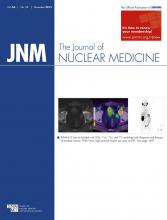R.A.J.O. Diercks, A. Otte, E.F.J. de Vries, and A. van Waarde, eds.
New York, NY: Springer, 2014, 818 pages, $399.00
This book contains information mainly on up-to-date PET and SPECT studies of pathologic markers and radiotracers targeting neurotransmitters and their possible clinical uses, as well as detailing the enormous recent progress in molecular neurobiology. Because of the excellent organization of the chapters, neuroscientists will easily locate their systems of interests and physicians will quickly locate up-to-date information on molecular imaging of specific brain disorders.
The organization of the book is according to the targeting molecules in neurobiologic systems. The first part presents the basics of PET and SPECT imaging while focusing more on preclinical studies. Starting with animal models of neurologic and psychiatric disorders, the fundamentals of small-animal PET and SPECT systems and protocols are covered. Emphasizing the capabilities of quantitation using PET and SPECT, this part is of the greatest help to readers who deal with animal studies. The last chapter in this part of the book describes the influence of genetic polymorphism on PET and SPECT studies of several neuroreceptor molecules.
The second part covers PET and SPECT imaging of specific systems. Except for Chapter 8, which presents PET tracers for β-amyloid and other proteinopathies, all the chapters cover specific neuroreceptors, transporters, or neurotransmitters. Each chapter introduces the biologic function of neurotransmitter systems and presents specific radioligands followed by preclinical/clinical studies. Detailed reviews of each system will be useful and attractive to any researcher studying specific systems. To explain why and how several radiotracers have been developed for each system, a portion of most chapters is devoted to a detailed introduction of each system and the related radiopharmaceuticals. For example, the chapter on the endocannabinoid system introduces the physiology of cannabinoid receptors in a concise and easy-to-understand manner and their related neuropsychiatric pathologies. After presenting radioligands for cannabinoid receptor subtypes, the chapter emphasizes current imaging studies and potential applications. Despite the holistic nature of the reviews for each system, the contents of the various chapters do not lose consistency and look well organized.
The chapter on the dopamine system briefly presents the radioligands and imaging studies. Considering that this system has been the most actively studied, we expected a better description. The description of clinical uses and outcomes in movement disorders—and the studies and findings on receptor occupancy—are insufficient. One chapter deals with central benzodiazepine receptors. It presents their possible usefulness in chronic cerebral ischemia, skipping other applications such as epilepsy. Other chapters, such as that on nicotinic acetylcholine receptor imaging, present a comprehensive summary of knowledge on previously released radiopharmaceuticals and their image findings, followed by up-to-date disease applications. The chapter on opioid receptor imaging presents the historical development and current wide use of a radioligand.
This book accomplished a job that is never easy. The authors describe most of the preclinical studies and include updated information on the development of radiotracers for every neurobiologic system. They rarely deal with the fundamentals of the kinetics for each tracer or with radiochemistry issues, especially for the neuroreceptors. If readers plan to develop a new tracer to target neurotransmitter systems or to find its application, reference to the relevant chapters will be a helpful starter to acquiring well-rounded knowledge in a specific scientific field within a reasonable time.
The editors have done an excellent job on this entire series of books. We envy their success at benefiting future readers.
Footnotes
Published online Aug. 20, 2015.
- © 2015 by the Society of Nuclear Medicine and Molecular Imaging, Inc.







